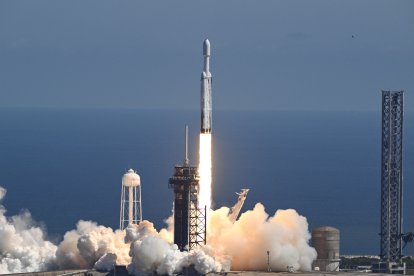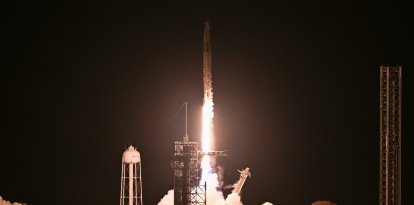NASA's giant Europa Clipper probe blasts off in search of life on other planets
The spacecraft will take measurements of Europa, a moon of Jupiter, to assess whether it meets the conditions necessary to harbor life.

Liftoff of the Europa Clipper spacecraft
The over 13,000-pound, 100-foot-long Europa Clipper probe lifted off successfully Monday from NASA's Kennedy Space Center in Florida.
The largest probe in the space agency's history left Earth atop a SpaceX Falcon Heavy rocket, bound for Jupiter's moon Europa. It is expected to arrive in 2030.
Its mission is to "determine if Jupiter's icy moon Europa currently has habitable conditions." It will orbit Europa 40 to 50 times over the course of four years to take measurements of the entire natural satellite.
Curt Niebur, in charge of the scientific portion of the mission, explained that it is "a chance for us to explore not a world that might have been habitable billions of years ago," like Mars, "but a world that might be habitable today — right now," per AFP.
On its unmanned journey of more than 1.8 billion miles, it will be powered by solar energy, extending solar panels designed to capture Jupiter's dim sunlight.
Searching for other habitable planets
The first close-up images of Europa, known to have existed since 1610, were made by the Voyager probe in 1979, which revealed the mysterious reddish lines on its surface, AFP reports.
In the 1990s, the Galileo probe confirmed the very likely presence of an ocean.
This time, the Europa Clipper carries several ultra-sophisticated instruments including cameras, a spectrograph, radar and a magnetometer. The mission should make it possible to determine the structure and composition of its frozen surface, the depth and even the salinity of the potential ocean.
This is all in order to understand if the three ingredients necessary for life are there: water, energy and some chemical compounds.
If they exist, life could be in the ocean in the form of primitive bacteria, explained Bonnie Buratti, the mission's deputy chief scientist, though too deep for Europa Clipper to see.
What if Europa ultimately wasn't habitable? "That also opens up a whole wealth of questions: Why did we think this? And why is it not there?" said Nikki Fox, NASA associate administrator.
RECOMMENDATION






















